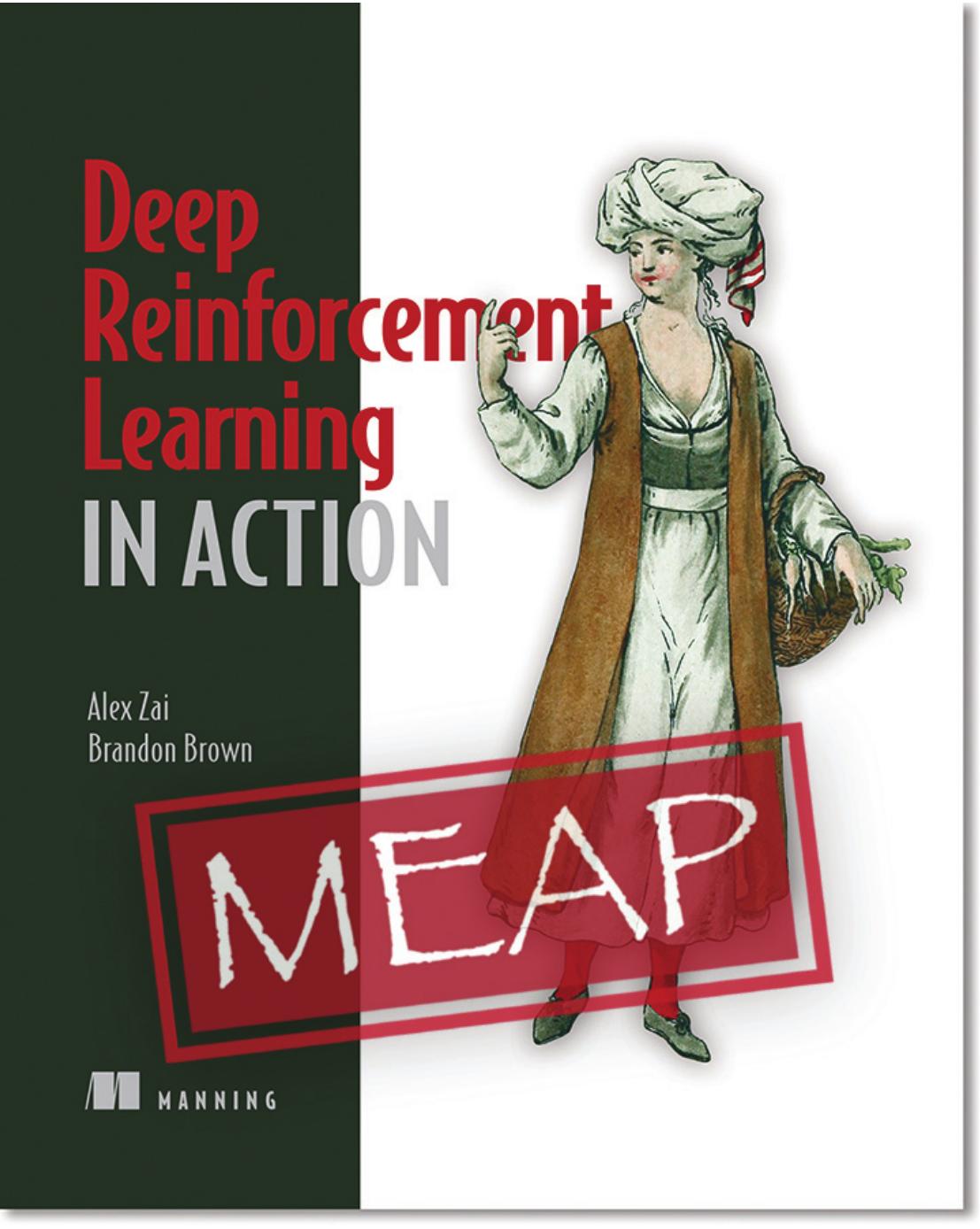Deep Reinforcement Learning in Action 1st edition by Brandon Brown, Alexander Zai ISBN 1638350507 9781638350507
$70.00 Original price was: $70.00.$35.00Current price is: $35.00.
Instant download Deep Reinforcement Learning in Action MEAP V07 after payment
Deep Reinforcement Learning in Action 1st edition by Brandon Brown, Alexander Zai – Ebook PDF Instant Download/Delivery: 1638350507, 9781638350507
Full download Deep Reinforcement Learning in Action 1st edition after payment

Product details:
ISBN 10: 1638350507
ISBN 13: 9781638350507
Author: Brandon Brown, Alexander Zai
Summary Humans learn best from feedback—we are encouraged to take actions that lead to positive results while deterred by decisions with negative consequences. This reinforcement process can be applied to computer programs allowing them to solve more complex problems that classical programming cannot. Deep Reinforcement Learning in Action teaches you the fundamental concepts and terminology of deep reinforcement learning, along with the practical skills and techniques you’ll need to implement it into your own projects. Purchase of the print book includes a free eBook in PDF, Kindle, and ePub formats from Manning Publications. About the technology Deep reinforcement learning AI systems rapidly adapt to new environments, a vast improvement over standard neural networks. A DRL agent learns like people do, taking in raw data such as sensor input and refining its responses and predictions through trial and error. About the book Deep Reinforcement Learning in Action teaches you how to program AI agents that adapt and improve based on direct feedback from their environment. In this example-rich tutorial, you’ll master foundational and advanced DRL techniques by taking on interesting challenges like navigating a maze and playing video games. Along the way, you’ll work with core algorithms, including deep Q-networks and policy gradients, along with industry-standard tools like PyTorch and OpenAI Gym. What’s inside Building and training DRL networks The most popular DRL algorithms for learning and problem solving Evolutionary algorithms for curiosity and multi-agent learning All examples available as Jupyter Notebooks About the reader For readers with intermediate skills in Python and deep learning. About the author Alexander Zai is a machine learning engineer at Amazon AI. Brandon Brown is a machine learning and data analysis blogger. Table of Contents PART 1 – FOUNDATIONS 1. What is reinforcement learning? 2. Modeling reinforcement learning problems: Markov decision processes 3. Predicting the best states and actions: Deep Q-networks 4. Learning to pick the best policy: Policy gradient methods 5. Tackling more complex problems with actor-critic methods PART 2 – ABOVE AND BEYOND 6. Alternative optimization methods: Evolutionary algorithms 7. Distributional DQN: Getting the full story 8.Curiosity-driven exploration 9. Multi-agent reinforcement learning 10. Interpretable reinforcement learning: Attention and relational models 11. In conclusion: A review and roadmap
Deep Reinforcement Learning in Action 1st Table of contents:
Part 1. Foundations
Chapter 1. What is reinforcement learning?
1.1. The “deep” in deep reinforcement learning
1.2. Reinforcement learning
1.3. Dynamic programming versus Monte Carlo
1.4. The reinforcement learning framework
1.5. What can I do with reinforcement learning?
1.6. Why deep reinforcement learning?
1.7. Our didactic tool: String diagrams
1.8. What’s next?
Summary
Chapter 2. Modeling reinforcement learning problems: Markov decision processes
2.1. String diagrams and our teaching methods
2.2. Solving the multi-arm bandit
2.3. Applying bandits to optimize ad placements
2.4. Building networks with PyTorch
2.5. Solving contextual bandits
2.6. The Markov property
2.7. Predicting future rewards: Value and policy functions
Summary
Chapter 3. Predicting the best states and actions: Deep Q-networks
3.1. The Q function
3.2. Navigating with Q-learning
3.3. Preventing catastrophic forgetting: Experience replay
3.4. Improving stability with a target network
3.5. Review
Summary
Chapter 4. Learning to pick the best policy: Policy gradient methods
4.1. Policy function using neural networks
4.2. Reinforcing good actions: The policy gradient algorithm
4.3. Working with OpenAI Gym
4.4. The REINFORCE algorithm
Summary
Chapter 5. Tackling more complex problems with actor-critic methods
5.1. Combining the value and policy function
5.2. Distributed training
5.3. Advantage actor-critic
5.4. N-step actor-critic
Summary
Part 2. Above and beyond
Chapter 6. Alternative optimization methods: Evolutionary algorithms
6.1. A different approach to reinforcement learning
6.2. Reinforcement learning with evolution strategies
6.3. A genetic algorithm for CartPole
6.4. Pros and cons of evolutionary algorithms
6.5. Evolutionary algorithms as a scalable alternative
Summary
Chapter 7. Distributional DQN: Getting the full story
7.1. What’s wrong with Q-learning?
7.2. Probability and statistics revisited
7.3. The Bellman equation
7.4. Distributional Q-learning
7.5. Comparing probability distributions
7.6. Dist-DQN on simulated data
7.7. Using distributional Q-learning to play Freeway
Summary
Chapter 8. Curiosity-driven exploration
8.1. Tackling sparse rewards with predictive coding
8.2. Inverse dynamics prediction
8.3. Setting up Super Mario Bros.
8.4. Preprocessing and the Q-network
8.5. Setting up the Q-network and policy function
8.6. Intrinsic curiosity module
8.7. Alternative intrinsic reward mechanisms
Summary
Chapter 9. Multi-agent reinforcement learning
9.1. From one to many agents
9.2. Neighborhood Q-learning
9.3. The 1D Ising model
9.4. Mean field Q-learning and the 2D Ising model
9.5. Mixed cooperative-competitive games
Summary
Chapter 10. Interpretable reinforcement learning: Attention and relational models
10.1. Machine learning interpretability with attention and relational biases
10.2. Relational reasoning with attention
10.3. Implementing self-attention for MNIST
10.4. Multi-head attention and relational DQN
10.5. Double Q-learning
10.6. Training and attention visualization
Summary
Chapter 11. In conclusion: A review and roadmap
11.1. What did we learn?
11.2. The uncharted topics in deep reinforcement learning
11.3. The end
Appendix. Mathematics, deep learning, PyTorch
A.1. Linear algebra
A.2. Calculus
A.3. Deep learning
A.4. PyTorch
Reference list
Index
List of Figures
List of Tables
List of Listings
People also search for Deep Reinforcement Learning in Action 1st :
action space shaping in deep reinforcement learning
deep reinforcement learning continuous action space
deep learning in action
a deep reinforcement learning-based framework for content caching
deep reinforcement learning actor critic
Tags: Brandon Brown, Alexander Zai, Deep Reinforcement, Learning in Action


